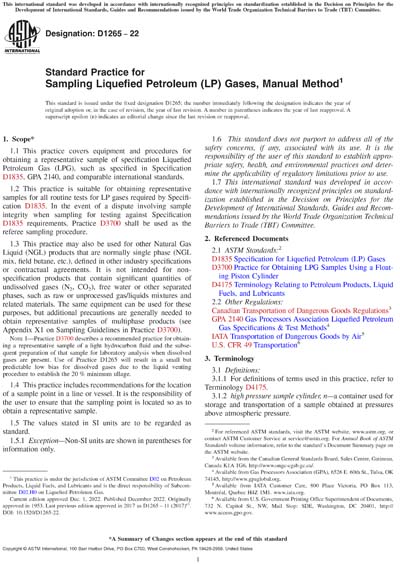Historical
ASTM D1265-22
Standard Practice for Sampling Liquefied Petroleum (LP) Gases, Manual Method
1.1This practice covers equipment and procedures for obtaining a representative sample of specification Liquefied Petroleum Gas (LPG), such as specified in Specification D1835, GPA 2140, and comparable international standards.
1.2This practice is suitable for obtaining representative samples for all routine tests for LP gases required by Specification D1835. In the event of a dispute involving sample integrity when sampling for testing against Specification D1835 requirements, Practice D3700 shall be used as the referee sampling procedure.
1.3This practice may also be used for other Natural Gas Liquid (NGL) products that are normally single phase (NGL mix, field butane, etc.), defined in other industry specifications or contractual agreements. It is not intended for non-specification products that contain significant quantities of undissolved gases (N2, CO2), free water or other separated phases, such as raw or unprocessed gas/liquids mixtures and related materials. The same equipment can be used for these purposes, but additional precautions are generally needed to obtain representative samples of multiphase products (see Appendix X1 on Sampling Guidelines in Practice D3700).
Note 1:Practice D3700 describes a recommended practice for obtaining a representative sample of a light hydrocarbon fluid and the subsequent preparation of that sample for laboratory analysis when dissolved gases are present. Use of Practice D1265 will result in a small but predictable low bias for dissolved gases due to the liquid venting procedure to establish the 20 % minimum ullage.
1.4This practice includes recommendations for the location of a sample point in a line or vessel. It is the responsibility of the user to ensure that the sampling point is located so as to obtain a representative sample.
1.5The values stated in SI units are to be regarded as standard.
1.5.1Exception - Non-SI units are shown in parentheses for information only.
1.6 This standard does not purport to address all of the safety concerns, if any, associated with its use. It is the responsibility of the user of this standard to establish appropriate safety, health, and environmental practices and determine the applicability of regulatory limitations prior to use.
1.7This international standard was developed in accordance with internationally recognized principles on standardization established in the Decision on Principles for the Development of International Standards, Guides and Recommendations issued by the World Trade Organization Technical Barriers to Trade (TBT) Committee.
ASTM International [astm]

